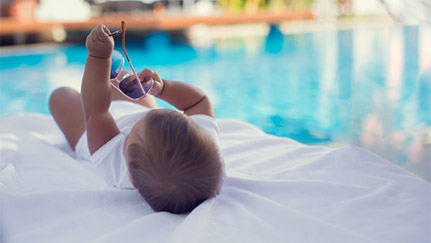
If you have a backyard pool or spa (or both), now is a good time to review all the measures you can take to keep your whole family safe while they’re in and around the water.
Here’s great advice from poolsafely.gov:
Rule #1: Never leave a child unattended while they’re in or near water.
Always watch children carefully when they’re in or near the pool. Designate an official Water Watcher, an adult tasked with supervising children in the water. That should be their only task — they shouldn’t be reading, texting or playing games on their phone. Keep a phone close by at all times in case you need to call for help, and if a child is missing, check the pool first.
Teach your children how to swim.
Swimming is not only fun, it’s a lifesaving skill, so enroll your kids in swimming lessons as soon as they’re old enough to get into the water.
Teach children to stay away from drains.
Make sure your kids and their swimming friends understand why it’s not safe to play or swim near drains or suction outlets, especially in spas and shallow pools. Their hair, limbs, jewelry or bathing suits can get stuck in a drain or suction opening.
Make sure your pool and spa have compliant drain covers.
No one should enter a pool or spa that has a loose, broken or missing drain cover. Powerful suction from a pool or spa drain can trap even an adult. When using a spa, be sure to locate the emergency vacuum shut-off before getting in the water.
Install proper barriers, covers and alarms on and around your pool and spa.
These can be lifesaving devices. A fence at least 4 feet tall should surround the pool or spa on all sides and should not be climbable for children. The water should be accessible only through a self-closing, self-latching gate. Teach children to never try to climb over the gate or fence. Install a door alarm from the house to the pool area, and keep pool and spa covers in good working order.
Know how to perform CPR on children and adults.
Often, bystanders are the first to aid a drowning victim, so learning CPR can help save a life. Once you’re CPR certified, make sure to keep your certification current. CPR classes are available through many hospitals and community centers, or by contacting the American Red Cross.1
Extra safety measures we highly recommend:
- When opening your pool for the season, hire a certified professional to check that the pool’s safety cover is working properly, the electrical components are up to snuff, and the fencing is solid, with self-closing and self-latching gates functioning as they should. Ask your service provider to check for and repair loose screws or rough edges that could catch bathing suits or hair and possibly trap swimmers. It’s also critical — and required under federal law — to check for displaced or absent drain covers.
- Buy an all-weather sign with CPR instructions to hang on the inside of your pool gate and be sure to print your home’s address on it in permanent marker in case anyone needs to call an ambulance.
- Never rely on water wings, floaties, inner tubes or noodles. These are pool toys. If someone needs added support in the pool, use only flotation devices labeled “Coast Guard-approved.”
- Keep your pool water clean and clear. It’s easier to see what’s happening under the surface, and you also reduce the risk of waterborne illnesses.
- Make sure to keep a lifesaving ring, floats and a shepherd’s crook reaching pole in the same spot near your pool at all times.
- Cover your pool with a rigid safety cover (preferably a motorized one) whenever you’re not using it, even during swimming season. Make sure the cover fits securely over the pool’s entire surface, so a child can’t get under it and become trapped.
- After swim time, collect and stow all toys and floats, which can be tempting to curious kids. Also, avoid chemical dispensers that look like toys.2
Backyard pools are lots of fun, but they do require responsible safety practices and extreme vigilance, especially when kids are around. Pay attention to everything that matters, so you’ll have only happy memories of your family’s time in the water.
[2] “Home Swimming Pool Safety Tips All Parents Should Know,” parents.com, Peg Rosen and Pamela Kramer, parents.com/kids/safety/outdoor/pool-drowning-safety-tips-for-parents (February 13, 2019).
The information used to create this article was obtained from sources believed to be reliable to help users address their own risk management and insurance needs. It does not and is not intended to provide legal advice. Nationwide, its affiliates and employees do not guarantee improved results based upon the information contained herein and assume no liability in connection with the information or the provided suggestions. The recommendations provided are general in nature; unique circumstances may not warrant or require implementation of some or all of the suggestions. Nationwide, the Nationwide N and Eagle and Nationwide Private Client are service marks of Nationwide Mutual Insurance Company.